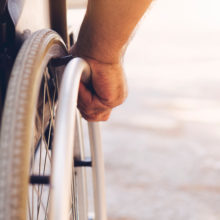Myositis is a condition that causes muscle weakness, pain, and sometimes rashes. Every year more than 7,000 people are diagnosed with this rare disease. Myositis symptoms can be so severe that they affect a person’s ability to work and perform simple activities of daily living.
When someone has widespread muscle pain and weakness it can be impossible for them to work. And when someone can’t work because of a medical condition it can cause severe financial hardship. Without money coming in to pay for housing, food, medical care, and other costs it can be very difficult for people to get by if they’re too sick to work.
Health insurance options
If you have private health insurance through your job or your partner’s job, myositis-related treatment and therapies may be covered depending on your health care plan. But just as with any chronic condition, you will be responsible for paying copays for every appointment and making sure that your deductible is met before any of the costs are picked up by insurance. It’s very important that you understand your coverage and what is and is not covered.
If your current private health insurance excludes certain types of care, including care for autoimmune disorders, you may want to see if there is a better insurance plan for you on the healthcare exchange. With Affordable Care Act subsidies and plans, it may be possible to find insurance that will cover more of your costs or reduce your out-of-pocket costs. You also may be able to find a plan that covers pre-existing conditions like myositis.
Social Security disability benefits
If you have myositis and the symptoms are so severe that you can’t work, you may qualify for Social Security Disability Insurance (SSDI) or Supplemental Security Income (SSI). If you have worked in the past but can’t work now, you can apply for SSDI. If you don’t have a work history and have very limited income and resources, you may be able to apply for SSI. You will still have to meet certain requirements spelled out in the Social Security Administration’s (SSA) Blue Book, a listing of disabling impairments.
Myositis qualifies for disability benefits under listing 14.05 in the SSA’s Blue Book. To qualify through this listing, you will have to provide medical evidence that shows you have at least one of these symptoms:
- Proximal muscle weakness in the shoulder or pelvis that affects your ability to use your arms or walk effectively
- Weakness of muscles involved in swallowing that allows fluids or solids to get into your lungs (aspiration)
- Weakness of the intercostal and diaphragmatic muscles causing impaired respiration
- Calcium buildup in the tissue, skin, or muscle that limits movement of the intestinal tract or joints (calcinosis)
You may also qualify for SSDI or SSI if you have ongoing fever, severe fatigue, malaise, or involuntary weight loss that is so severe it limits your ability to function or work. You would have to qualify for a residual functional capacity if that is the case.
Nonprofit Organizations and Foundations
If you have myositis and are waiting for your Social Security disability application to be approved, or if you don’t qualify for disability benefits, you may be able to get financial help from one of these programs:
- The Myositis Association has a long list of financial resources for those struggling to make ends meet because of myositis, including information on financial support and discounts on healthcare and medication.
- The Assistance Fund may be accepting new applications for help paying for myositis medications. If not, you can join the wait list and apply for the next round of funding.
- The Myositis Support and Understanding offers grants of up to $2000 to help people who have been diagnosed with myositis pay for living expenses.
Government assistance programs
There can sometimes be a long wait for financial help from private nonprofit groups, but there may be government assistance for anyone who needs help paying for living expenses because of myositis. Medicaid and Medicare may be able to help cover some of the costs of treatment and therapies for myositis.
Medicaid is a federal health insurance program that is open to low-income individuals as well as women, children, and disabled people. Medicare is available to seniors over the age of 65. There may also be state-specific programs that can help, depending on the state that you live in.
Crowdfunding and fundraising
Crowdfunding for medical care and living expenses has become a popular way for people to get direct support. When you crowdfund on sites like GoFundMe, it gives people a greater sense of security so they may be more likely to donate money to help you than if you ask for payments directly through financial services like Venmo or CashApp.
Developing a chronic disabling condition like myositis can be scary because of the financial uncertainty it brings. But there are lots of resources that are available to help you pay for the things you need when you’re too sick to work.
Eric Minghella is Outreach Manager at Disability Benefits Help. They provide information about disability benefits and the application process. To learn more, please visit their website at http://www.disability-benefits-help.org/ or by emailing them at help@ssd-help.org.


Qué tipo de ayuda es la que proporciona, yo soy una persona ilegal y tengo myositis y bastantes problemas económicos ya que no puedo trabajar desde hace un año aproximadamente.
Gracias…..
Hello Jose, I’m afraid TMA does not have a financial assistance fund. However, our friends at Myositis Support and Understanding do have such financial assistance. https://understandingmyositis.org/
Hola José, Me temo que TMA no tiene un fondo de asistencia financiera. Sin embargo, nuestros amigos de Myositis Support and Understanding cuentan con dicha asistencia financiera. https://understandingmyositis.org/
hello there if I am the one with Myositis how come every member in the household income has to be included on the request for assistance financial application?